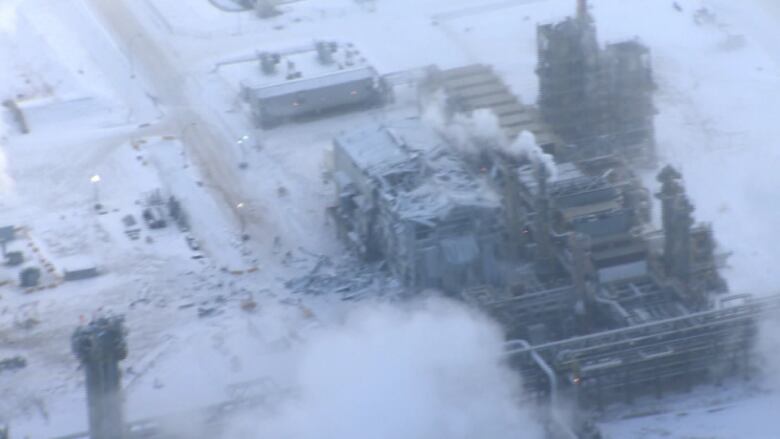China not exactly striking it rich in Canadian oilpatch
Prize asset in CNOOC-Nexen deal still struggling to live up to expectations

The Chinese-owned Long Lake facility in Alberta's oilsands could be shut down for a few yearsafter a fatal explosion in January. The ongoing investigationrepresents another setback for Nexen and for Chinese investment in the Alberta oilpatch, to the extent some experts wonder whetherChina has any interest left in Canadian resources.
There's been a lot ofheadwindscombined with paying a high price and not managing the assets as best as they could- LannyPendill, oilsands analyst
Calgary-basedNexenwas purchased by China'sCNOOCLtd. in July 2012for $15.1 billion in cash.Nexenhad assets aroundthe world,but the Long Lake project was the centrepiece of the deal as China was looking to gain a foothold in the Albertaoilsands.
Long Lake had a history of problems as it tried to live up to its production targets and the struggles continued as the facility moved into Chinese hands.
- Oil and gas sector says investment will drop by $50B
- Oilsands investment from China shrinks after Nexen deal
"On a cash cost basis they would have been struggling even without the shut in," said Kevin Birn, an oilsandsanalyst with the IHS Energy Group."It's not very pretty. Nexen is backed by one of the world's largest oil companies, so it's not a threat to the stability of the company, it's how do they feel about that asset over the long term."
Fatal explosion, pipeline leak
The recent problems at Long Lake began with a pipeline spill in July whenfive million litres of bitumen, sand and oil leaked from a pipe at thefacility. The plant had to temporarily shut down.

Occupational Heath and Safety (OHS) is investigating the explosion and has a stop work order for an area of the facility where the fatal explosion occurred. The investigation could take up to two yearsand OHS may recommend crown prosecutors lay charges against the company.
Currently, the facility is allowed to produce about 20,000 barrels of oil a day compared to the facility's capacity of 70,000 barrels a day.
"It's the minimum level necessary to keep the bitumen in the lines from solidifying and it allows the entire facility to remain at a near idle state until they are authorized to go back into full production," saidRiley Bender, a spokesman with the Alberta Energy Regulator.
Nexen did not respond to several requests for comment.
Big price, little profit
CNOOC's purchase of Nexen was good news for Nexen shareholders. They receiveda 61per cent premiumover the share price when the deal was announced.
"It was almost like a white knight coming in and paying a fairly decent price relative to the price ofNexenat the time," saidLannyPendill, a senior analyst with Edward Jones.
But, four years later,industry watchers considerthedeal a financial blunder for CNOOC.

Oilsandsprojects are complex, energy intensive facilities that use high temperatures to extract bitumen from the ground. Pendillsuggestspart of the issueis the "direct result ofCNOOCstarting to manage the business," withoutoilsandsexperience.
China's interest flagging
The deal isn't regarded favourably in China, either.
"Today, most people view that as a failure," said Edy Wong, an associate dean at the University of Alberta, who studies international business."They overpaid for the asset and they have not been able to do very well."
Purchasing Nexen allowedCNOOC to diversify its assets, but Wong said this deal is like many other Chinese investments in the Alberta oilpatchthe revenues have not met expectations.
"From the perspective of state companies, the large enterprises, Canada is probably not considered to be a very attractive destination," he said. "Companies like CNOOC, Sinopec, etc Canada has not worked out very well for them and consequently, they are not looking to Canada as a place where they will increase their investment in the near future."
Wong suggests Chinese companies are having much more financial success from operations in Africa, central Asia and to a lesser extent in South America.
"When we look at a lot of the medium sized companies from China, who have invested in [Canadian]junior oil companies, most have not turned a profit. The rate of return for even the big companies, it's not there," he said.
The reason Chineseinvestments haven'talways paid off is because of several factors. Many deals occurredwhen oil prices were high and there have been two downturns in the last decade.
"Unfortunately the Chinese did a lot of deals before the last crash in 2009. There has been a recovery but now another crash," saidPendill, the Edward Jones analyst."There's been a lot of headwinds combined with paying a high price and not managing the assets as best as they could."
Future investment
The poor track record of Chinese investment in the oilpatch raises questions about whether there will be any more buying in the coming years.Concerns about whether any export pipelines will be constructed is anotherreason why future investment is not a sure thing.
Still, Pendillis not ruling it out.
"I don't think the Chinese are done, even inside Canada and the oilsands," he said.
China's population keeps growing and so does its demand for energy. It must look outside its borders to supply its needs for decades to come.
"Hopefully they've learned from their mistakes and those future investments will turn out better than past investments have."












_(720p).jpg)


 OFFICIAL HD MUSIC VIDEO.jpg)
.jpg)



























































































